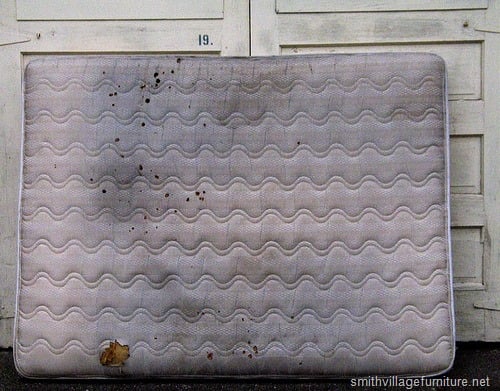
How To Clean Any Mattress: The Ultimate Guide
The average mattress can last between 5 – 10 years, depending on the type and quality of that mattress. As such, its important to keep your mattress as clean as possible.
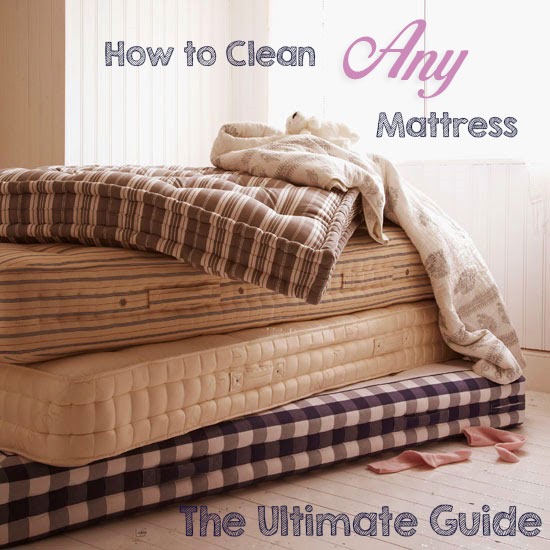
What’s Inside the Ultimate Mattress Cleaning Guide:
- Regular Cleaning
- Removing Common Stains
- Deodorising Lingering Smells
- Cleaning Your Memory Foam Mattress
- Getting Rid of Mould & Mildew
- Banishing Bed Bugs


About every 3 months you should undertake a deep clean of your mattress, to keep it in a good condition. A lot of medical conditions can be caused by an unclean mattress, so it’s important to make it a regular part of your cleaning routine:
1. Vacuum
Vacuum your mattress on both sides to remove the build up of dust and dead skin cells that have inevitably built up over the course of the month. This is particularly important if you suffer from allergies or skin conditions.
TOP TIP: If you have a steamer, use it to go over the mattress before you vacuum, to help kill and remove dust mites that might be lurking near the surface.
2. Air
Before putting clean sheets back onto your mattress, allow it to ‘air’ – ideally outside in the sun, but if that’s not possible a well-ventilated sunlit room will work as well. The sun helps to kill bacteria and dry-out moisture build-up in the mattress. Try leaving the mattress for at least two hours, flipping the mattress so that both sides receive the benefit.
3. Deodorise
It’s important to deodorise your mattress as smells can build up over time (due to sweat, moisture etc.).
Be careful of using shop-bought products that claim to deodorise, as many of these do not actually remove the odour and just cover it up with stronger chemical smells.
Dust a light sprinkling of baking soda over the surface of the mattress (if you want, you can also add a few drops of essential oil). Leave for at least an hour, and then vacuum again thoroughly. The baking soda lifts any remaining dirt, and is a great natural deodoriser.
TOP TIP: You should also turn your mattress every 1-3 months, to keep it from ‘warping’ and increase the longevity of your mattress (unless you have a no-turn mattress, such as a foam mattress).

One of the most important things to remember when cleaning a mattress is to avoid over-saturating the mattress with your cleaning solution. A damp mattress takes a long time to dry, and if not dried properly can develop foul odours and mould and mildew (see section below). Bear that in mind if a large amount of liquid has been spilled onto your mattress, because if it has penetrated and stained the deeper inside layers it will be harder to clean completely - and you may have to invest in a new mattress.
TOP TIP: To help prevent mattress stains use a mattress topper, which can be machine-washed and easily replaced in the event of a stain. You could also consider a waterproof mattress.
SWEAT
Did you know the average person sweats out around 1/2 pint of perspiration every single night? It seems pretty disgusting when you say it like that, but it’s a natural bodily function that happens to us all. However, over time this can leave your mattress feeling un-fresh, and may even leave some unsightly stains.
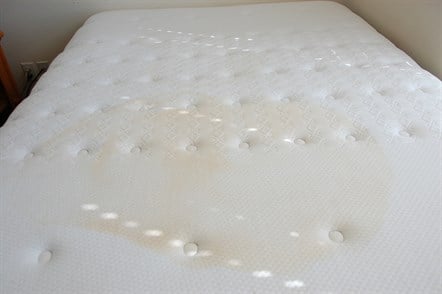
TOP TIP: Do NOT use a bleach solution in an attempt to remove the stain. Bleach will make the stain worse by spreading it, and is too harsh to use on common mattress materials.
Top Rated Home Remedies
Method #1: Detergent & Water
- Mix 2oz of powdered detergent with 300ml of warm water (mix well until soap suds form)
- Apply a thin layer onto the mattress stain and rub in with a sponge
- Keep working the mixture until you see the stain start to fade
- Once the stain has faded/disappeared, switch to a clean sponge and wipe until no more detergent remains
- Leave to dry completely (you can use a hair-dryer to help speed up this process)
Method #2: Borax
- Dampen the stain with water
- Pour a small amount of Borax onto the stain and rub gently in a circular motion (you should notice the stain fading)
- Once the stain is covered and faded/removed, leave the Borax to dry on the stain
- Vacuum the Borax once dried
- Repeat if necessary
URINE
This stain is tough because the odour must be removed as well. Preventing the urine from soaking into the mattress is crucial. Use paper towels to blot up as much of the excess liquid as possible.
TOP TIP: Prevention is easier than a cure. Use a mattress protector or a waterproof mattress if you have young children.
Read our guide on "Do You Need a Mattress Protector?" for a complete run down on this fantastic addition to any bed.

For fresh urine deposits:
Method #1: Spraying White Vinegar
- Soak up as much urine as possible by blotting with paper towels. Apply plenty of pressure to reach the deeper layers of the mattress
- Spray the fresh stain with a white vinegar solution (two parts lukewarm water, one part distilled white vinegar)
- Blot with a paper towel
- Repeat steps 2 and 3 multiple times to remove the stain and smell from the mattress
- Allow to air dry
- Remove any leftover residue from the solution by applying a small amount of water to the area and blotting dry
Method #2: Using a Carpet Cleaner
- Soak up as much urine as possible by blotting with paper towels
- Follow the instructions of your chosen carpet cleaner as normal (but on the mattress, not the carpet – obviously)
For old, dried urine stains:
Be aware, that long-term urine exposure can actually ‘burn’ the dyes in the fabric of the mattress, causing irreversible damage. If the urine has been left to sit, it can be impossible to remove the odour completely.
Method #1: Aggie MacKenzie’s Method
- Lightly sponge the surface with a cold solution of washing-up liquid or upholstery cleaner – don’t get it too wet
- Rinse by sponging with cold water with a few drops of disinfectant
- Leave until thoroughly dry
Method #2: Vinegar & Baking Soda
- Dilute some vinegar in warm water (typically half and half works fine)
- Spray the solution on affected area then blot dry
- Sprinkle generous amounts of baking soda and leave overnight (this will get rid of the smell)
- Vacuum the baking soda the next day
For Pet Urine:
An enzyme cleaner is recommended for removing pet urine stains. The enzymes break down uric acid into carbon dioxide and ammonia, both gasses that then easily evaporate.
- Blot up as much of the urine as you can before applying
- Apply enzyme cleaner to affected area (following the labelled instructions)
- Let the enzyme cleaner sit for between 10-15 minutes
- Blot up as much of the cleaner as possible
- Leave to air dry
Beware that an older stain may require this process to be repeated two or three times in order to completely clean the stain.
Top Rated Enzyme Cleaners (UK):
Mattress Stain Remover (3.5-star rating, 28 reviews)
Urine Off (3.5-star Amazon rating, 198 reviews)
Simple Solution Stain and Odour Remover (4-star Amazon rating, 98 reviews)
BLOOD
Blood stains can be one of the most challenging stains to get out of your mattress, particularly if they are old and dried. Old blood stains may require several applications before the stain is gone or at least less noticeable.
NOTE: If you find small dots of blood on your sheets and mattress and cannot determine the source, you may have bed bugs.
For Fresh Stains:
Method #1: Water & Salt
- Mix 2 teaspoons of salt with 300ml of cold water and pour the solution into a spray bottle (Do NOT use warm water, as this can set the stain even more)
- Spray the affected area
- Blot the area with a dry cloth to absorb excess
- Repeat steps 2 & 3 until the stain is gone or the cloth is not absorbing any more blood
- Use a damp cloth (cold water) to rinse the remaining solution
- Dry the area with a dry cloth
Method #2: Baking Soda
- Mix 4oz of baking soda with 600ml cold water
- Apply the solution to the stained area with a cloth
- Leave for 30 minutes
- Use a damp cloth to rinse thoroughly
- Use a dry towel to absorb excess and dry the mattress
For a complete guide on cleaning blood from your mattress, read our Step-by-Step Guide on How to Get Blood of Out of a Mattress.
For Dried Stains:
Method #1: Meat Tenderizer
Blood contains protein and meat tenderizer breaks down protein.
- Mix 1 tablespoon of meat tenderizer with 2 teaspoons of cold water to form a paste
- Spread the paste over the stain and gently rub in
- Leave for 1 hour
- Brush off excess paste with a damp cloth
- Use a dry towel to absorb the moisture
Method #2: Hydrogen Peroxide
NOTE: Hydrogen peroxide is a bleaching agent. Use with care and be aware that you may change the colour of the fabric of the mattress.
- Mix 4oz of cornstarch, 1 tablespoon of salt and 2oz of hydrogen peroxide to form a paste
- Apply some of the paste to the stain
- Blood stains will foam up on contact with hydrogen peroxide. Blot at the blood that comes up with the foam immediately to quickly remove a large amount of the stain
- Apply a generous layer of paste to the stain and leave until completely dry (this may take a couple of hours)
- Once paste is dry, scrape off and vacuum the area thoroughly
- If stain persists, repeat process until the stain has been properly removed
Top 3 Stain-Removal Products (You Can Buy):
Inspired Mattress Stain Remover (4-star Amazon rating, 166 reviews)
Stain Slayer (4-star Amazon rating, 114 reviews)
Prochem Stain Pro (4.5-star Amazon rating, 13 reviews)
If you are still having trouble with particularly stubborn stains, then it may be time to seek professional help. A quick search online or through the yellow-pages should give you a list of local companies to contact.

Once odours are absorbed into your mattress they can be difficult to remove, but not impossible.
Be careful of using shop-bought products that claim to deodorise, as many of these do not actually remove the odour and just cover it up with stronger chemical smells.
TOP TIP: Keep your mattress smelling fresh by placing a scented dryer sheet between the mattress and the fitted bed sheet
Home Deodorising Remedies:
Method #1: Baking Soda
Baking soda removes odours by balancing pH levels. Sprinkle baking soda on top of the mattress and allow to sit for several hours. Brush and vacuum off.
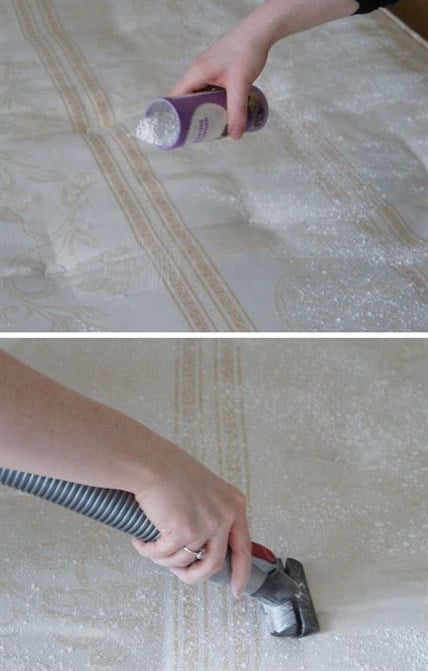
Method #2: Plain White Vinegar
Vinegar is a great natural deodoriser – yes, your bedroom may smell like a Fish & Chip Shop for the first hour, but it will go away!
- Vacuum the mattress to remove all dust and dirt
- Fill a spray bottle with white vinegar
- Spray vinegar over the entire mattress
- Let the mattress air dry completely
TOP TIP: If you can, let the mattress dry in the sun, as this will completely dry out the mattress and is effective at helping to remove lingering odours
Top Rated Deodorising Products (You Can Buy):
Sta-Kill Deodoriser (4-star Amazon rating, 58 reviews)
Inspired Mattress Deodoriser (4-star Amazon rating, 21 reviews)
Good Ideas Professional Mattress Deodoriser (4.5-star Amazon rating, 17 reviews)

You may think that your memory foam mattress will be a nightmare to clean, but it’s actually fairly easy. Most memory foam mattresses are fitted with a removable cover which is machine washable.
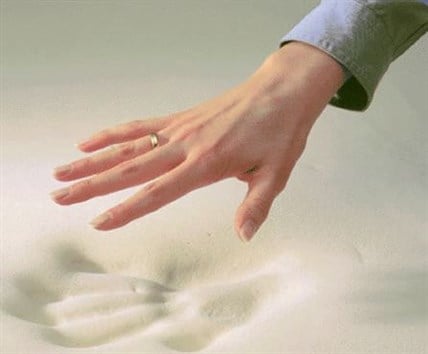
NOTE: Steam cleaning memory foam mattresses and toppers may ruin them and is not recommended.
TOP TIP: Before you attempt to tackle your memory foam stain, it may be a good idea to check the mattress manufacturer’s warranty, as it may cover stain removal.
Deep Clean & Stain Removal for Your Foam Mattress
- Most memory foam mattress come with a zipped fabric cover. Remove this and wash in the washing machine as directed
- Vacuum the mattress. This will remove surface dirt and dust that has built up
- Mix 4oz fabric softener with 300ml water and put in a spray bottle.
- Stand the memory foam mattress on one end and spray the mixed solution on both sides of the mattress and leave for 30 minutes.
- Rinse with clean water, using a detachable shower head/hose
- Gently squeeze out excess water by pushing – DO NOT twist or wring the foam
- Mix 60ml distilled white vinegar with 300ml water and spray both sides of the mattress (like you did in step 4)
- Rinse again and press out excess (steps 5 and 6)
- Leave the mattress to dry completely. This can take a couple of days. If you wish, you can aid the drying process by using a hair dryer (on its lowest heat setting) or an electric fan

Mould is a fungus that grows in warm and moist environments. If your mattress gets wet and isn’t dried out properly it can become a breeding ground for mould and mildew. Mould and mildew can be hazardous to your health, causing allergic reactions and respiratory problems.
Saving Your Mattress from Mildew
If you notice mildew growing on your mattress, cleaning the mattress with a solution of disinfectant as soon as possible could save your bed, especially if the mildew appears to be only on the surface.
- Vacuum both sides of the mattress (immediately clean/dispose of your dust catcher to avoid spreading mould spores)
- Mix 300ml warm water with 300ml rubbing (isopropyl) alcohol
- Use a cloth to scrub the mildew stain – try to be as gentle as possible to avoid damaging the fabric
- Allow the mattress to dry (outside in direct sunlight if possible) for at least several hours, until completely dry
- Spray a disinfectant evenly over the entire mattress to kill any remaining spores (do not saturate the mattress)
- Allow the mattress to dry completely
NOTE: If your mattress still smells mouldy or the stains continue to grow after repeating this process a few times, throw it out.
If You Find Black Mould on Your Mattress
Chuck it. The mould will have penetrated the inside of the mattress and that is impossible to clean. Try purchasing a latex mattress (latex is naturally mould resistant) or looking at the airflow and air quality in your bedroom and seeing if you can make some improvements.

Bed bugs may not be considered dangerous, but they’re certainly not a welcome guest in any home. Feeding on blood, bed bugs are attracted by your body heat and the carbon dioxide you expel, crawling out at night from the cracks and crevices they live in.
Signs of Infestation
- Unexplained blood stains on your sheets/mattress
- Unexplained skin rashes or itchy bumps
- Black spots on your sheets/mattress (either mottled shells the bed bugs have shed or their faeces)
- Live bed bugs
If you think you have bed bugs, you should immediately remove any clothes/soft furnishings that may be near to the bed to prevent the infestation from spreading further. Remove your bedding and wash in hot water for at least 30 minutes (to kill any live bugs/eggs that may be on your sheets).
You are advised to seek professional assistance from a reputable pest control company if you think you have bed bugs. This is by far the most effective way of ensuring that the infestation is properly irradiated. However, there are some home remedies you can try if you feel that the infestation isn’t too bad or if you cannot afford professional assistance right away:
Getting Rid of Bed Bugs: Home Remedies
1. Vacuum Thoroughly
Approximately 70% of all bed bugs in a typical infestation are located in the mattress. Thoroughly vacuum the entire mattress, bed frame and surrounding area. Make sure you get in all those little crevices, creases and folds in the mattress.
But don’t stop there, be sure to vacuum the entire affected room, including the floor, curtains etc. Once finished, remove and discard the vacuum bag straight away.
You are going to need to vacuum the mattress and the carpet regularly until the bed bugs are completely gone.
2. Insecticide
There are plenty of insecticides specifically designed for bed bugs. Always read and follow the instructions that come with your chosen insecticide.
Repeat this step after several days, and again monthly to prevent re-infestation.
3. Steam fabric and furniture
Bed bugs are extremely sensitive to heat, which is why steaming fabric and furniture is an effective treatment method (which also kills the eggs). If possible, opt for a dry steam which will allow for faster drying time and will reduce the possibility of fabric damage.
Steam each and every crevice in your bedroom floor and walls too, as the steam is able to penetrate those hard-to-reach areas much better than any other alternative.
For more in-depth guides on how to remove a bed bug infestation from your home, please see the following:
Where Do Bed Bugs Come From & How to Get Rid?
Preventing Bed Bugs
There are a number of things you can do to prevent bed bugs from invading your home:
-
Don’t Bring Bed Bugs Home with You - If you experience bed bugs at a hotel or similar place, make sure you don’t bring them home with you! Wash clothes on a hot cycle and disinfect your luggage bags with a form of insecticide.
-
Use Bed Bug Resistant Mattress/Sheets - Manufacturers are now able to produce bed-bug resistant mattresses and bedding. Waterproof mattresses are also effective at keeping bed bugs at bay.
-
Be Weary of Second-hand Furniture - Never bring second-hand furniture into your home without first inspecting for signs of bed bugs. mites, tics etc.
Latest Blog Posts

What Does It Mean to Have Dreams of Teeth Falling Out?
Posted on 16/04/2024
Do You Need a Mattress Protector? Understanding the Benefits for Your Bedding
Posted on 08/03/2024
What Do Dreams of Spiders Mean? Unpacking Their Mysteries
Posted on 07/03/2024
Should I Sleep With a Pillow Between My Legs? Understanding the Health Benefits
Posted on 06/03/2024
